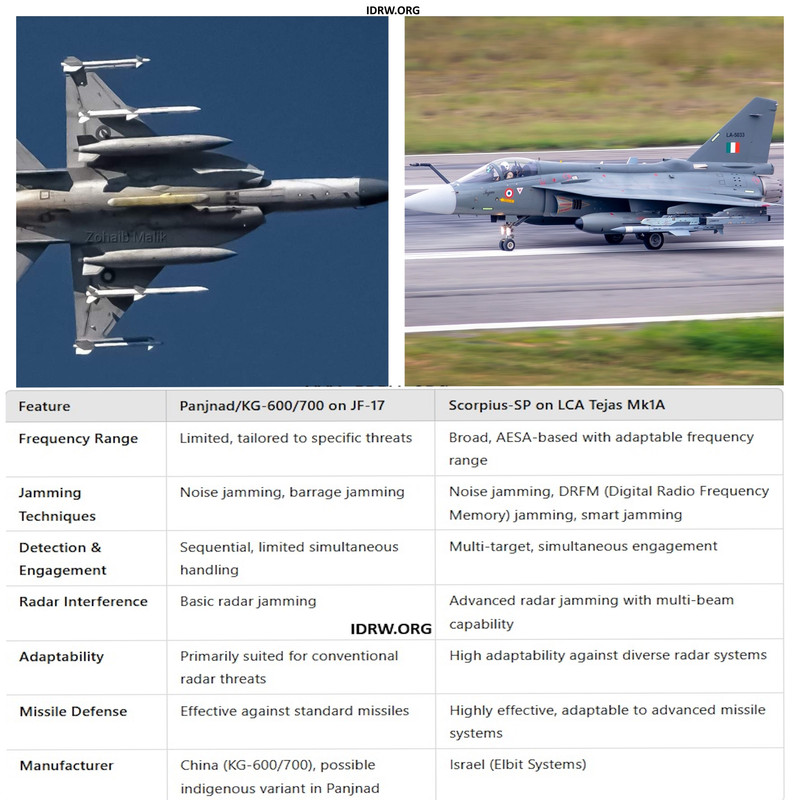SOURCE: AFI


Electronic Warfare (EW) plays an increasingly crucial role in modern aerial combat, as it enables aircraft to avoid detection, disrupt enemy radars, and defend against missile threats. Two prominent self-protection jamming systems—the Panjnad/KG-600/700 series on Pakistan’s JF-17 and the Israeli-made Scorpius-SP system on India’s LCA Tejas Mk1A—highlight differing technological approaches and strategic goals. Here, we delve into a detailed comparison of these systems in terms of capability, range, adaptability, and strategic advantages.
The JF-17 Thunder, developed jointly by Pakistan and China, utilizes the KG-600 and potentially KG-700 jamming pods. These pods are believed to have originated from Chinese EW technology and are intended to improve the JF-17’s survivability in contested airspace.
Recently, Pakistan revealed the Panjnad jamming pod, which might either be an indigenous evolution of the KG-600/700 or a locally manufactured variant. These jammers are designed for self-protection and electronic countermeasures against enemy radar and missile systems.
The Scorpius-SP, developed by Israeli defence firm Elbit Systems, is a state-of-the-art airborne self-protection jammer used on India’s Tejas Mk1A. Known for its advanced AESA (Active Electronically Scanned Array) technology, Scorpius-SP is part of Israel’s next-generation EW suite, designed to detect, track, and engage multiple threats simultaneously. Unlike traditional jammers, which operate on a narrow spectrum, the Scorpius-SP can cover a wide frequency range, making it more versatile and capable of jamming advanced radars.
The KG-600 series uses traditional jamming methods with limited frequency agility. This limits its effectiveness in complex, multi-frequency combat environments. The Panjnad variant may offer some improvements but remains relatively narrow in scope, optimized for basic radar jamming and limited types of surface-to-air threats.
he AESA-based Scorpius-SP can operate across a broad frequency range, allowing it to adapt to diverse radar threats. This adaptability makes it highly effective in modern, high-intensity conflict zones where adversaries might deploy multi-spectrum radar systems and frequency-hopping techniques.
The KG-600’s primary techniques are noise jamming and barrage jamming, effective against traditional radar and some older missile guidance systems. However, it lacks advanced features like DRFM, which can mimic enemy radar signals to create highly deceptive false targets.
Equipped with advanced jamming techniques such as DRFM, the Scorpius-SP can simulate multiple targets, creating confusion for enemy radar operators. This makes it more resilient against tracking and engagement by enemy air-defense systems, especially those utilizing frequency-hopping radars.
The KG-600 series can typically engage only one or two targets at a time, limiting its effectiveness in saturated threat environments where multiple missiles may be launched simultaneously.
The Scorpius-SP’s multi-beam technology allows it to jam multiple targets simultaneously, a critical capability in high-stakes air operations. This provides superior protection against advanced missile systems that may engage in swarming or simultaneous attack tactics.
While effective against many conventional threats, the KG-600 may struggle against newer, multi-spectral missile seekers. This could limit the JF-17’s ability to operate effectively in contested airspaces where next-generation missiles are deployed.
The Scorpius-SP’s advanced capabilities extend to countering next-generation missile systems, including those equipped with advanced radar seekers. This makes the Tejas Mk1A more survivable in complex, high-threat environments.
The KG-600 and potentially the Panjnad pods appear to rely heavily on Chinese technology, which limits Pakistan’s control over technological evolution and support. While the Panjnad is reportedly a Pakistani variant, it may still rely on Chinese components and technology.
While the Scorpius-SP is sourced from Israel, India’s defense partnership with Israel provides a collaborative edge in customization, technology transfers, and maintenance. This close partnership enhances operational readiness and long-term sustainability.
Strategic Implications
The Scorpius-SP offers superior multi-target engagement, making the Tejas Mk1A highly effective in diverse operational scenarios. In contrast, the Panjnad/KG-600 offers essential self-protection but lacks the comprehensive capability needed for advanced threat environments, limiting the JF-17’s deployment flexibility. The Tejas Mk1A, equipped with Scorpius-SP, can potentially outperform the JF-17 in terms of survivability against both aerial and ground-based threats. The advanced AESA capabilities of Scorpius-SP grant it an edge in high-intensity combat, where frequency adaptability and multi-target capabilities are paramount.